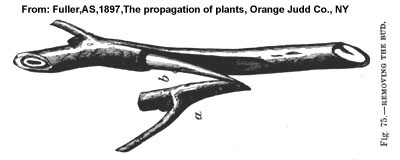>> T-budding
|
Application: Widely used for clonal propagation of temperate and tropical fruit trees and temperate ornamental shade trees. Tropical fruit trees such as citrus are T-budded onto seedling rootstocks largely to maintain the reproductive maturity of scion adult phase scion wood, and to take advantage of specific rootstock effects of various species rootstocks. Temperate ornamental shade tree such as cultivars of red maple, honey locust, green ash, and norway maple are budded onto seedling rootstocks, because they are difficult to root from cuttings or otherwise clonally propagate. . Hardy roses are T-budded onto field grown rootstocks lined out in nursery beds. |
|
| Greenhouse roses are T-budded onto rooted shoot cuttings either after rooting , or before rooting (a practice known as stenting) in the greenhouse. |  |
Timing:T-budding must be performed while the rind (bark) is "slipping" (peels easily from the underlying wood), which corresponds with periods when the vascular cambium is active (spring, summer). During stock plant dormancy (winter, early spring, late fall), or drought stress, rind grafting methods like T-budding cannot be performed because the bark will tear, rather than slip. T-budding of apples is done in late August in upstate New York, while the tree is still in leaf and and actively photosynthesising, but after dormant buds have been set earlier in the growing season, in response to shortening summer days. . At this time the bark is still slipping even though dormant buds have been set. An advantage of fall (late summer) budding is that transpiration and potential water stress is reduced when buds are dormant compared to actively elongating shoots in the spring. |
|
|
How to T-bud: |
|
|
A "T" shaped
cut is made in the bark,
near the base of the rootstock, and the bark is peeled
away from the underlying wood, creating a
"pouch".
|
|
|
Scion bud
shields are cut starting from below the bud to obtain a pointed end
that can be easily inserted into the stock "pouch" from top down. Note:
the bud stick in this image is being held upside down
|
 |
|
Multiple buds
can be cut from a single
bud stick (base is on the right side of the image)
|
 |
|
Some grafters
prefer to pull the rind (bark) of the scion bud shield away from the underlying
wood, and just use the rind, while other grafters leave the bud intact.
This shows one means of removing the wood.
|
 |
|
The bud shield
is slid into the pouch.
|
 |
|
After the graft union has formed (in the case of the apple, the following spring) the portion of the stock above the bud is cut or broken off to force the bud into growth |
 |
Additional Information:
|
Source:
Hort 400 Autotutorial on Apple Grafting by Mudge &
Caldwell |
|
Source:
Texas A&M University Teaching, Research & Extension
Resource / Aggie Horticulture |
|
Source:
Hort 400 Autotutorial on T-budding of Citrus |
|
Source:
Hort 494 T-budding
Laboratory Exercise |